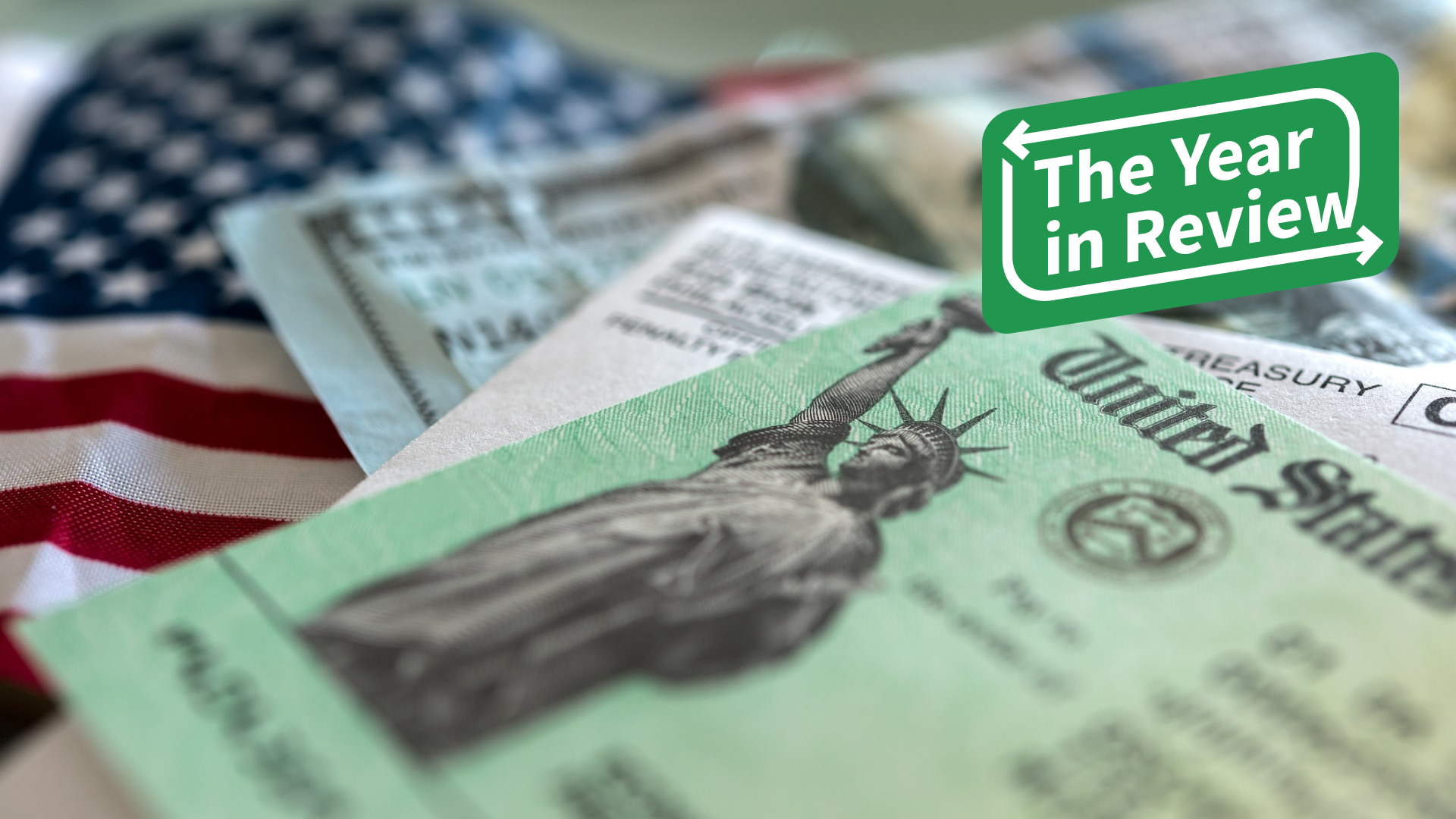Advertiser Disclosure
GOBankingRates works with many financial advertisers to showcase their products and services to our audiences. These brands compensate us to advertise their products in ads across our site. This compensation may impact how and where products appear on this site. We are not a comparison-tool and these offers do not represent all available deposit, investment, loan or credit products.
Stimulus Checks Totaled Over $850 Billion: See How That Money Was Spread Out
 Written by
John Csiszar
Written by
John Csiszar
 Edited by
Molly Sullivan
Edited by
Molly Sullivan

Commitment to Our Readers
GOBankingRates' editorial team is committed to bringing you unbiased reviews and information. We use data-driven methodologies to evaluate financial products and services - our reviews and ratings are not influenced by advertisers. You can read more about our editorial guidelines and our products and services review methodology.

20 YearsHelping You Live Richer

Reviewed by Experts

Trusted by Millions of Readers
The outbreak of the coronavirus pandemic in 2020 wreaked havoc on the global economy, shuttering businesses worldwide and triggering huge spikes in unemployment.
Social Security Schedule: When the First COLA Checks Will Arrive in January 2022
Social Security 2022: How the COLA Will Increase Benefits for the Average Senior Couple
In the U.S., Congress authorized direct stimulus payments to Americans via a series of bills over 2020 and 2021. Here’s a quick look at the details of each of the three rounds of stimulus payments sent to Americans, along with an analysis of what triggered them and what the ramifications have been.
Coronavirus Aid, Relief and Economic Security (CARES) Act
The first response from the U.S. Congress to the economic calamity of the coronavirus pandemic was the Coronavirus Aid, Relief and Economic Security Act, also known as the CARES Act. Congress passed the CARES Act on March 25, 2020, and it was signed into law by President Donald Trump on March 27, 2020.
What Did The CARES Act Do?
The CARES Act authorized direct payments to taxpayers in the amount of $1,200, or $2,400 for those filing jointly. Additional payments of $500 per qualifying child were also included in the legislation. Income limits were imposed so that the money did not flow to high-income taxpayers. Taxpayers with incomes above these amounts were ineligible for the payments:
- $99,000 for single taxpayers
- $198,000 for married couples filing jointly
- $136,500 for taxpayers filing as head of household
Starting at AGIs of $75,000, $150,000 and $112,500, respectively, payments began to be phased out, with the exact amount of the phase-out dependent upon whether or not taxpayers had qualifying children. Eligible individuals received their stimulus payments via direct deposit, check or prepaid debit card.
Read: When Social Security Runs Out: What the Program Will Look Like in 2035
Consolidated Appropriations Act, 2021
As a supplement to the CARES Act, which wasn’t sufficient to address the scope of the pandemic in the eyes of Congress, the Consolidated Appropriations Act of 2021 was passed on Dec. 21, 2020, and signed into law by President Trump on Dec. 27, 2020.
See: 17 Tips To Live Comfortably Off Just a Social Security Check
What Did the Consolidate Appropriations Act Do?
The Consolidated Appropriations Act of 2021 felt to most taxpayers as simply a repeat of the CARES Act, although with different payout amounts and income limitations. Specifically, the Consolidated Appropriations Act paid out $600 per person, or $1,200 for married individuals, in addition to a $600 payment for each qualifying child. Essentially, payouts were halved for taxpayers and increased by $100 for children when compared with the CARES Act. Income limitations were also different, as follows:
- $87,000 for single taxpayers
- $174,000 for married taxpayers filing jointly
- $124,500 for taxpayers filing as head of household
Payment amounts began being phased out at $75,000, $150,000 and $112,500, respectively, the same phaseout limits as under the CARES Act.
American Rescue Plan
The third and final round of stimulus checks — at least as of Nov. 23, 2021 — was approved and passed into law on March 11, 2021. Known as the American Rescue Plan, this phase of the stimulus was the most generous of all, especially to individuals with qualifying children.
What Did the American Rescue Plan Do?
Under the terms of the legislation, individuals were paid $1,400, or $2,800 per married couple, with an additional $1,400 per eligible child. Maximum income limits for the third stimulus check were as follows:
- $80,000 for single taxpayers
- $160,000 for joint filers
- $120,000 for taxpayers filing as head of household
Phaseout levels began at $75,000, $150,000 and $112,500, respectively. As with other stimulus checks, phaseout amounts could vary depending on whether or not taxpayers had qualifying children.
What Triggered the Need for Stimulus Checks?
Stimulus checks were promoted as a way to keep Americans afloat during unprecedented surges in unemployment and economic uncertainty. Between stay-at-home orders and forced closures of businesses, many Americans lost access to a regular paycheck. As referenced in The New York Times, an analysis of Census Bureau data seemed to indicate that the stimulus payments succeeded by improving Americans’ ability to pay for basic needs while reducing anxiety and depression.
Be Prepared:
Did Businesses Receive Any Stimulus Support?
While the three rounds of government stimulus checks were directed at individuals and their children, businesses were also provided with access to much-needed funds. On top of more traditional funding, such as SBA 7(a) loans, qualifying companies had access to two rounds of Paycheck Protection Program funding, which provided forgivable loans to help companies keep employees on the payroll. The Economic Injury Disaster Loan program was expanded to businesses across the country, offering low-rate, 30-year loans to companies in need of aid.
Will There Be Additional Rounds of Stimulus Checks?
Whenever the government hands out money to businesses and/or individuals, there will always be those clamoring for more. Various additional stimulus plans have been proposed, including the suggestion of providing ongoing, monthly payments directly to individuals of as much as $2,000. However, as of November 2021, both the Biden administration and Congress have indicated no appetite for providing additional stimulus payments.
How Much Did All of This Stimulus Cost?
By the end of all three rounds of stimulus, the U.S. government had provided over $850 billion in direct payments to taxpayers. The first round, the CARES Act, distributed $292 billion in payments, followed by $164 billion distributed under the Consolidated Appropriations Act. The final stimulus payments, made under the authorization of the American Rescue Plan, amounted to $411 billion.
More From GOBankingRates
Share this article:




You May Also Like

I Asked ChatGPT How the Rich Hide Money in Trusts: Here's Its Explanation
November 19, 2025
5 min Read

8 in 10 Workers Getting More Work Without More Pay -- How To Deal With 'Ghost Growth' Without Getting Fired
November 19, 2025
5 min Read

I Asked ChatGPT If There Are Any Ways To Get Rich Quick That Actually Work
November 14, 2025
5 min Read

Mark Cuban: Use Your Free Time To Learn AI -- and Watch the Job Offers Roll In
November 20, 2025
5 min Read

Why Do Shriners and Other Charities Ask You To Give Exactly $19 a Month?
November 19, 2025
5 min Read


This Rare Bicentennial Quarter Has Nearly $20K Value -- Plus 7 More Worth Thousands
November 19, 2025
5 min Read


3 Key Financial Moves To Make Before 2026 Hits, According to Humphrey Yang
November 14, 2025
5 min Read

Millionaires Now Own Nearly Half of the World's Personal Wealth -- Here's What It Means
November 19, 2025
5 min Read
Questions Around The Economy
Make your money work for you
Get the latest news on investing, money, and more with our free newsletter.
By subscribing, you agree to our Terms of Use and Privacy Policy. Unsubscribe at any time.


Thanks!
You're now subscribed to our newsletter.
Check your inbox for more details.



Sending you timely financial stories that you can bank on.
Sign up for our daily newsletter for the latest financial news and trending topics.
For our full Privacy Policy, click here.
Looks like you're using an adblocker
Please disable your adblocker to enjoy the optimal web experience and access the quality content you appreciate from GOBankingRates.
- AdBlock / uBlock / Brave
- Click the ad blocker extension icon to the right of the address bar
- Disable on this site
- Refresh the page
- Firefox / Edge / DuckDuckGo
- Click on the icon to the left of the address bar
- Disable Tracking Protection
- Refresh the page
- Ghostery
- Click the blue ghost icon to the right of the address bar
- Disable Ad-Blocking, Anti-Tracking, and Never-Consent
- Refresh the page








